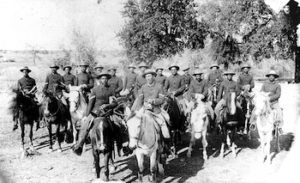
*On this date in 1870, Black Seminole Scouts are remembered. Also known as the Seminole Negro Indian Scouts or Seminole Scouts, they were commissioned by the United States Army.
Despite the name, the unit included both Black Seminoles and some Native Seminoles. However, because most of the Seminole scouts were of African descent, they were often attached to the Buffalo Soldier regiments to guide the troops through hostile territory. Most of their service was in the 1870s, in which they significantly ended the Texas-Indian Wars. By 1870, the native Seminoles lived on a reservation in the Indian Territory but originally came from Florida. Before the United States government banned slavery in December 1865, several hundred Black freedmen escaped their masters and sought refuge among the Seminoles in Florida.
Not long after the Seminoles were removed to the Indian Territory, the Black Seminoles, as they became, went to Coahuila, Mexico, to escape enslavement. The Mexicans welcomed them there and were later joined by native Seminoles, Black Creeks, and Black Cherokees. In 1870, the United States Army issued a message to the Black Seminoles' chief, John Horse, inviting him and his band to return to the United States to enlist as Indian scouts and help fight hostile Native Americans. The Black Seminoles, about 200 people, accepted the agreement, believing that they would be granted land in the United States, food, provisions, and reimbursement for travel costs. However, over the years, none of these conditions were met. The future scouts crossed the international border on
July 4 that year and were officially mustered into service on August 18 at Fort Duncan, near Eagle Pass, Texas. However, in July 1872, most scouts were moved to Fort Clark, near Brackettville. John Ward, Adam Paine, Pompey Factor, Isaac Payne, and others were enlisted. Their first able commander was a Quaker and Civil War veteran, Lieutenant John L. Bullis; the others were too unreliable to control the unit. Having been a commander of black soldiers during the American Civil War, his men trusted Bullis and even asked to perform marriages for the tribe. Between May 1872 and 1881, the Seminole scouts fought in several effective engagements with Comanches, Kiowas, Apaches, and Kickapoos, sometimes traveling into Mexico, the Indian Territory, and Kansas.
The Black Seminole Scouts were disbanded twenty-one years later, in 1914, and most were forced to leave the Fort Clark reservation with their families. Just twenty-seven Black Seminoles were allowed to remain at the fort, but only until the group's elders had departed. The official report of the disbandment reads as follows: The duration of an enlistment agreement was six months until the 20th century. This reflected the scouts' disinterest in long-term commitments and the Army's opinion that the need for scouts would not last long. Some scouts served more than once. Within the scouting community, certain surnames were well known. Of the 152 scouts that served between 1870 and 1914, there were seventeen "Wilsons"s, eleven "Paynes"s, eight "Julys," seven "Factors," seven "Bowlegs," six "Washingtons"s, six "Daniels"s, and six "Bruners"s. Many of these families also intermarried.